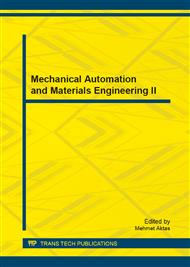p.670
p.675
p.681
p.686
p.693
p.697
p.701
p.705
p.710
Design of Soil Pollution and Restoration Simulation System Based on LabVIEW and PLC
Abstract:
With the world's population growth the industrialization process and the unreasonable use of the environment,soil pollution problem has been increasingly prominent, the soil will become another shortage resource. This article introduces akind of soil pollution and restoration simulation system,the whole system simulates proliferation, migration and transformation process of different pollutants in different soil types, different hydrogeological environment three-dimensional space. The systerm also uses physical and chemical, biological and other repair method to repair contaminated soil. The use of LabVIEW graphical programming language to design PC man-machine interface looks simple and intuitive. Based on LabVlEW serial communication function, we develop the LabVIEW and PLC communication driver and achieve the real-time monitoring of the whole system ,which provides equipment and data support for the pollution of the soil.
Info:
Periodical:
Pages:
693-696
Citation:
Online since:
June 2014
Authors:
Keywords:
Price:
Сopyright:
© 2014 Trans Tech Publications Ltd. All Rights Reserved
Share:
Citation:


